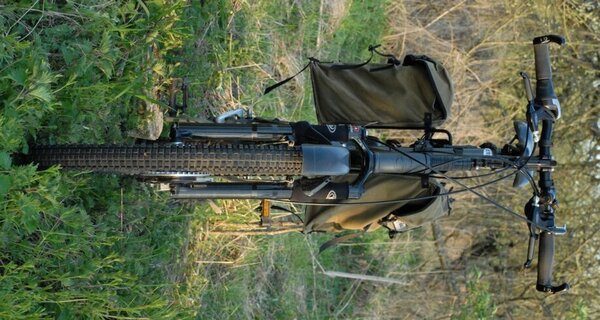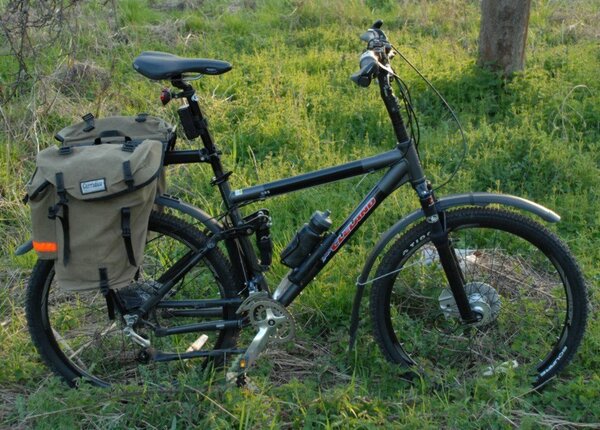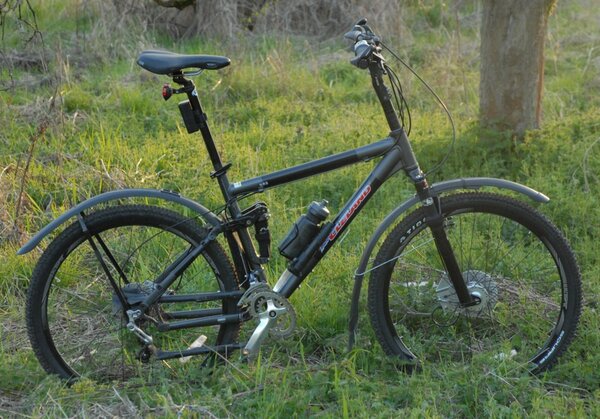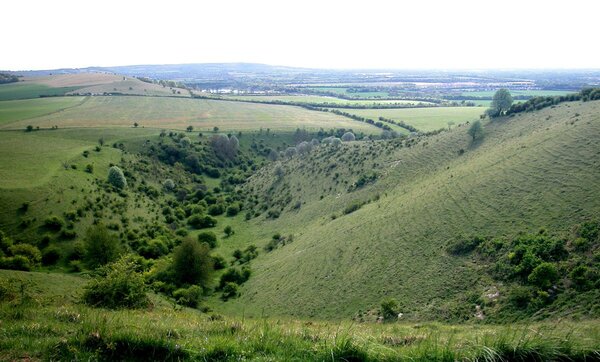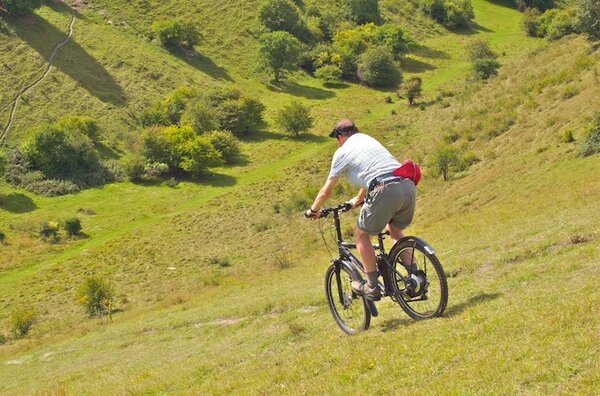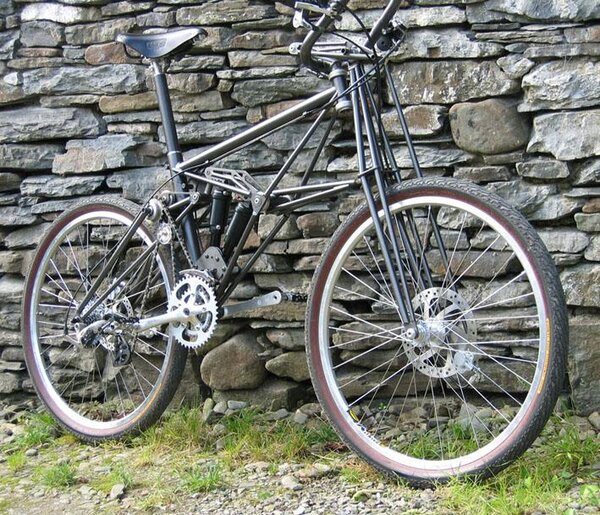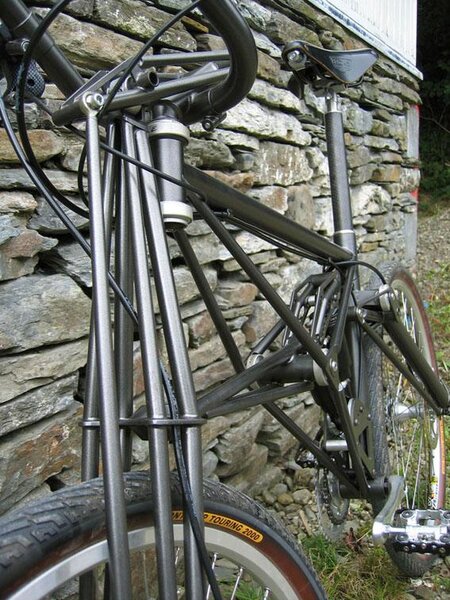You are using an out of date browser. It may not display this or other websites correctly.
You should upgrade or use an alternative browser.
You should upgrade or use an alternative browser.
Modern Clelands
- Thread starter GrahamJohnWallace
- Start date
- Feedback
- View
The Cleland NRS
Unlike the Cleland TT which is highly developed design that could go into production tomorrow, the Cleland NRS is an in development design to test whether suspension is compatible with the Cleland ethos.
Based around a small framed Giant NRS, this is also a testbed for a wide range of components and Ideas. To reduce maintenance, the chain runs through plastic tubes and the suspension systems are sealed. The handle bars can be used high or angled by up to 90 degrees, so as offer both Cleland and Mountain bike riding positions. The mudguards are designed to keep the rider clean above the knee, and they also move with the suspension. The suspension is normally preloaded with zero sag, so that the bike can be hopped over obstacles and climb like a hard tail. For improved comfort over less hilly or technical terrain, it can be adjusted to run with normal sag.
It is not a finished, ready for market product. But a steppingstone to a future design, intended to give an unrivaled combination of performance, safety and comfort.
This is my design but inspired by Geoff's 1980's designs (especially his small wheeled Dingbat). And the Shimano inter8 Brakes and gears are copied from Geoff's 2006 Aventura II prototype.
Geoff has been involved in the development of these bikes. He has ridden one of them and subsequently given his permission for use of the Cleland name.
Though strictly speaking any bike that rides like a Cleland, is a Cleland.
Unlike the Cleland TT which is highly developed design that could go into production tomorrow, the Cleland NRS is an in development design to test whether suspension is compatible with the Cleland ethos.
Based around a small framed Giant NRS, this is also a testbed for a wide range of components and Ideas. To reduce maintenance, the chain runs through plastic tubes and the suspension systems are sealed. The handle bars can be used high or angled by up to 90 degrees, so as offer both Cleland and Mountain bike riding positions. The mudguards are designed to keep the rider clean above the knee, and they also move with the suspension. The suspension is normally preloaded with zero sag, so that the bike can be hopped over obstacles and climb like a hard tail. For improved comfort over less hilly or technical terrain, it can be adjusted to run with normal sag.
It is not a finished, ready for market product. But a steppingstone to a future design, intended to give an unrivaled combination of performance, safety and comfort.
This is my design but inspired by Geoff's 1980's designs (especially his small wheeled Dingbat). And the Shimano inter8 Brakes and gears are copied from Geoff's 2006 Aventura II prototype.
Geoff has been involved in the development of these bikes. He has ridden one of them and subsequently given his permission for use of the Cleland name.
Though strictly speaking any bike that rides like a Cleland, is a Cleland.
Attachments
- Feedback
- View
The hill on the right is where I test the controlled braking characteristics of bikes.
Locking up the wheels on this slope is not recommended. Lock up the front brake and the rear wheel will lift off the ground and almost certainly flip you over the handle bars. Lock up the rear and you will start to pick up speed as well as damaging the slope. You can ride down by crossing the camber, but again any locking of wheels will result in side slip. The most difficult sections are the front wheel traps where you need to momentarily release the front brake and then regain control of the speed once the danger is passed.
So far the Cleland NRS's RollerBrakes are best. They function silently and have superb modulation characteristics. Some local rider try this slope using hydraulic disk brakes but don't get very far without either crashing or chickening out. I suspect that a mechanical disk brake set up could be suitable, possibly with a hydraulic rear brake.
The Cleland riding position helps as you have the get out option of jumping off the back if things go wrong. I am considering riding this slope on my 1983 Cleland Aventura as its hub brakes have enough modulation. However, the lack of suspension could be a problem when it comes to negotiating the wheel traps.
Locking up the wheels on this slope is not recommended. Lock up the front brake and the rear wheel will lift off the ground and almost certainly flip you over the handle bars. Lock up the rear and you will start to pick up speed as well as damaging the slope. You can ride down by crossing the camber, but again any locking of wheels will result in side slip. The most difficult sections are the front wheel traps where you need to momentarily release the front brake and then regain control of the speed once the danger is passed.
So far the Cleland NRS's RollerBrakes are best. They function silently and have superb modulation characteristics. Some local rider try this slope using hydraulic disk brakes but don't get very far without either crashing or chickening out. I suspect that a mechanical disk brake set up could be suitable, possibly with a hydraulic rear brake.
The Cleland riding position helps as you have the get out option of jumping off the back if things go wrong. I am considering riding this slope on my 1983 Cleland Aventura as its hub brakes have enough modulation. However, the lack of suspension could be a problem when it comes to negotiating the wheel traps.
Attachments
- Feedback
- View
That looks very similar to Devil's Dike nr Brighton
You'll like this, as thats where I found out my Cannondale's hydraulic brakes didnt work...
You'll like this, as thats where I found out my Cannondale's hydraulic brakes didnt work...
- Feedback
- View
Geoff Apps is featured in this months CTC magazine 
- Feedback
- View
REKIBorter":1hoqo673 said:Geoff Apps is featured in this months CTC magazine
That's Good. One of the problems of getting Geoff inducted into the MTB Hall of Fame is that, despite being well respected by the American pioneers, his story is not known by the vast majority of cyclists.
- Feedback
- View
Descending Cleland style
The Cleland's high handlebars help the rider to lean as far back as possible. The Shimano RollerBrakes have very large cooling disks to prevent brake fade caused by overheating.
The brakes are smooth and quiet and easily moderated so as to prevent a potentially disasterous front wheel lockout. The rear wheel does very little of the braking but keeping it rotating improves control, and reduces any surface damage to a minimum.
There is no run out at the bottom, just a thicket of shrubs and trees. So it's important to maintain full control and not build up speed.
The Cleland's high handlebars help the rider to lean as far back as possible. The Shimano RollerBrakes have very large cooling disks to prevent brake fade caused by overheating.
The brakes are smooth and quiet and easily moderated so as to prevent a potentially disasterous front wheel lockout. The rear wheel does very little of the braking but keeping it rotating improves control, and reduces any surface damage to a minimum.
There is no run out at the bottom, just a thicket of shrubs and trees. So it's important to maintain full control and not build up speed.
Attachments
- Feedback
- View
This is the TopTrail.
It uses a very sophisticated and complex combination of suspension, articulation, anti-dive and anti-squat brakes.
Those of you with an eye for detail will notice that the riding position is not the exactly the bolt upright Cleland style. So why have I included it as a modern Cleland?
The main reason is because its articulation system works in exactly the same way as the Cleland's. With a Cleland you stand upright on the pedals and let the whole bike articulate, see-saw style underneath you with a rowing motion of the arms as the handlebars rise and fall. The complex mechanism of the TopTrail allows this to be done whilst the handlebars and saddle remain virtually still.
Articulated suspension systems are not a new idea, the Model T Ford had an articulated front axle and modern military vehicles have combined articulation and suspension systems. However this is the first system I have seen used on a bicycle. It only works because of the anti-dive and anti-squat brake and indirect transmission systems stop the bike from behaving like a rocking horse.
The second reason is that it was made by Cleland Guru, David Wrath-Sharman. and designed by Adrian Griffiths
Checkout this videos on the TopTrail site.
http://toptrail.co.uk/
With a normal suspension bike an impact pushes against a spring that in tern causes the the rider's body weight to react by moving and rotating away from the impact. On the TopTrail the spring is much weaker and the riders body weight is lifted only slightly without rotating. This is much more efficient than suspension alone, as the riders body moves less and so less damping is required in order to settle the system down.
http://toptrail.co.uk/docs/MB_suspensio ... 050606.pdf
It uses a very sophisticated and complex combination of suspension, articulation, anti-dive and anti-squat brakes.
Those of you with an eye for detail will notice that the riding position is not the exactly the bolt upright Cleland style. So why have I included it as a modern Cleland?
The main reason is because its articulation system works in exactly the same way as the Cleland's. With a Cleland you stand upright on the pedals and let the whole bike articulate, see-saw style underneath you with a rowing motion of the arms as the handlebars rise and fall. The complex mechanism of the TopTrail allows this to be done whilst the handlebars and saddle remain virtually still.
Articulated suspension systems are not a new idea, the Model T Ford had an articulated front axle and modern military vehicles have combined articulation and suspension systems. However this is the first system I have seen used on a bicycle. It only works because of the anti-dive and anti-squat brake and indirect transmission systems stop the bike from behaving like a rocking horse.
The second reason is that it was made by Cleland Guru, David Wrath-Sharman. and designed by Adrian Griffiths
Checkout this videos on the TopTrail site.
http://toptrail.co.uk/
With a normal suspension bike an impact pushes against a spring that in tern causes the the rider's body weight to react by moving and rotating away from the impact. On the TopTrail the spring is much weaker and the riders body weight is lifted only slightly without rotating. This is much more efficient than suspension alone, as the riders body moves less and so less damping is required in order to settle the system down.
http://toptrail.co.uk/docs/MB_suspensio ... 050606.pdf
Attachments
- Feedback
- View
isnt the front caliper just a wee bit vulnerable where it is?
Similar threads
- Replies
- 1
- Views
- 698
- Replies
- 0
- Views
- 916
- Replies
- 5
- Views
- 987
